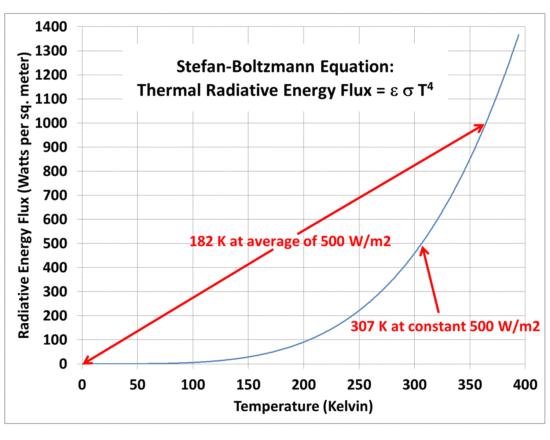This is a followup to my post from yesterday where I provided time-dependent model results of the day-night cycle in lunar temperatures.
One of the fascinating things about the model result (which I would not have expected) is that all other things being equal, the faster a solar-illuminated planet rotates, the warmer its average temperature will be. The calculations I provided are for planets without an atmosphere (e.g. the Moon).
Before examining the issue, I would have guessed that the rotation rate would not matter. Or, maybe I would have guessed that a more-slowly rotating planet would get warmer, since the period of sunlight is longer and higher daytime temperatures would be achieved.
But I would have been wrong.
Simple Thought Experiment
The reason is very simple, and is related to the non-linearity of the Stefan-Boltzmann equation, which can be used to estimate how warm a body gets based upon the rate at which it absorbs solar energy when its only mechanism to cool is through thermal emission of radiation:

Fig. 1. The non-linearity of the Stefan-Boltzmann equation can lead to very different average planetary temperatures given the same long-term average absorbed solar flux.
Imagine a body with a realistic heat capacity that uniformly absorbs a solar intensity of 1,000 Watts per sq. meter for 1 second, then 0 W/m2 for one second, over and over. Think of it as a 2 sec long diurnal cycle. That rapidly flickering energy source would be too fast for the temperature to come into equilibrium with the absorbed sunlight (or lack of sunlight). It would, in effect, be like a continuous energy source of 500 W/m2 in intensity, and the resulting S-B temperature (assuming a thermal radiative emissivity of 1.0) would be about 307 Kelvin, taken from the curve in Fig. 1.
Now imagine the energy source stays on for a very long time, say 10,000 days, then stays off for 10,000 days (a 20,000 day diurnal cycle…the Moon has a 29.5 day diurnal cycle). From Fig. 1 we see that during the daytime the temperature would approach 365 Kelvin, and at night it would approach 0 Kelvin. In this case the average temperature would be about 182 Kelvin…which is 125 deg. colder than 307 K!
The only difference in the two imaginary cases is the length of the day/night cycle. The long-term average rate of absorbed sunlight is the same.
Yesterday I showed that the difference in rotation rate between the Earth and the Moon caused the more-slowly rotating Moon to be about 55 deg. colder than the Earth, all other things being equal (no atmosphere, the same albedo and IR emissivity, and a surface bulk heat capacity which gives model temperatures than match actual lunar observations). The effect is muted the greater the surface bulk heat capacity, since that also reduces the diurnal temperature range.
Basically, any process which increases the day-night temperature range (such as a longer diurnal cycle) will decrease the average temperature of a planet, simply because of the non-linearity of the S-B equation. I suspect the effect does not exist if the surface being heated has zero heat capacity, since the temperature of the surface will instantly come into equilibrium with the absorbed sunlight; in that case the length of day would not matter. But since that is physically impossible, it does not apply to real planets.

 Home/Blog
Home/Blog




I would of thought factors like dams, buildings, and wind farms providing friction and pressure differentials in the boundary layer would slow the Earths rotation and have a warming. Rossby waves from the Earths rotation and Coriolis effect are already stronger in the said Northern hemisphere due to more land, the highest mountains, and more land sea boundaries. Rossby waves are linked to extreme weather and amplified warming of the Arctic as well as destabilising the polar vortex preventing stratospheric clouds from forming a prerequisite for solar wind depleting the ozone layer after Solar dawn in Spring.